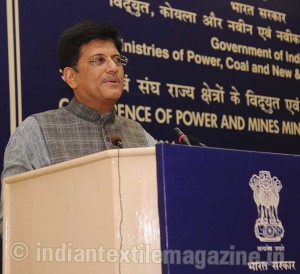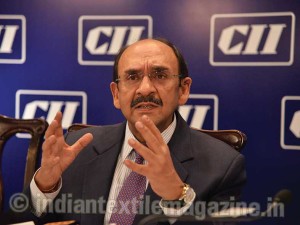Plan to make India clean energy capital
A massive overhaul of the power sector is underway with the Government planning to bring in a series of amendments to the Electricity Act 2003 across all segments of the power value chain within the current session of Parliament. “I am looking at a billion tonne coal production, 100 GW of solar power capacity and investments of about $50 billion in the transmission and distribution segment in the next five years,” said Mr. Piyush Goyal, Minister of State, Independent Charge for Power, Coal and New & Renewable Energy, while addressing the CII National Council meeting organized in the capital.

In a bid to boost renewable energy which is targeted to be 15 per cent of the energy mix by 2020, the Government is set to impose stringent penalties on errant discoms who fail to meet the renewable purchase obligations. This will be clubbed with a renewable obligation on generators by which all conventional power producers like NTPC will have to be accountable for some proportion of renewable power.
Significantly, while the Minister highlighted the need to revive gas-based power projects in the system to create a balance of base and peak power, he also spoke in detail about the reforms and corrective steps being taken to address coal supply and evacuation issues. Some of the steps he cited included increasing the number of rakes involving an investment of $1 billion and rationalizing coal linkages and swapping to optimize costs and save almost Rs. 6,000 crores.
Reforms are also being planned for the distribution companies. The Government is making provisions whereby the entire discom set-up will be unbundled. While there will be a government distributor of power to ensure that power is provided to the weaker sections of society, competition will be introduced and the private sector role in the sector expanded.
Highlighting that the coal and electricity sectors are reflective of the change in governance that the new government has brought about, Mr. Goyal said, “the electricity and coal production has risen by 11.3 per cent and 10.2 per cent respectively during June-October 2014.”
Elaborating on how focusing on outcome-oriented steps and time-bound execution helped in the resolution of key issues, he said: “With hydel capacity being challenged due to a poor monsoon, the Government was faced with the Hobson’s choice of consuming the available stocks and generating more power. The electricity sector was able to increase production by 20 per cent during the June-July-August period. Similarly, the Coal Ordinance is a step in the direction of setting right a wrong of 20 years. Another issue that was resolved satisfactorily through a dialogue with the industry was anti-dumping duty. Going forward, I see a flourishing domestic renewable energy manufacturing industry co-existing with a massive development phase which will achieve the ambitious target of 100 gw by 2022. This is also reflective of our commitments to environment and climate change”.

Talking about RE-INVEST, an initiative of the Ministry of New and Renewable Energy to catalyse investments in the sector, he observed: “The Government is hoping to come forward with a clear-cut roadmap on how to achieve the 100 GW solar target at RE-INVEST which is scheduled in February 2015. We urge the industry to evaluate the business propositions in this sector, make commitments towards green energy and join us in making India a solar super power of the world.”
Discussing the innovative financing models and the new framework that the government is now evaluating, he said: “Innovative financing models have helped make solar energy a viable business proposition. We are looking at graded tariffs to achieve grid parity, provide investors a fair return on investment over the lifecycle of the project, and bring in an entity to provide power purchase assurance to investors.”
Emphasising on the business case for investments in renewable energy, particularly for large investors, he said, “Factoring in accelerated depreciation benefits and leveraging the strong balance sheets to avail of the benefits of lower interest rates will help reduce the cost of solar power downwards of Rs. 5 and at par with conventional power. This can change the whole economics of the business.”
Lauding the reforms undertaken by the Power Ministry, Mr. Ajay S. Shriram, CII President, said: “The first big reform has been in the coal sector where a change in the 40-year story has been undertaken with one stroke of legislation. As we understand, this Bill, when passed by Parliament, will enable private players to commence commercial mining. Similarly, the Ministry of New and Renewable Energy has undertaken a huge target of installing a capacity of 100 Giga watts of solar by 2022 and a similar target for wind energy. This is a step in the right direction as it is critical to harness renewable energy from an energy security perspective, given that India is heavily reliant on imports to meet its energy requirements.